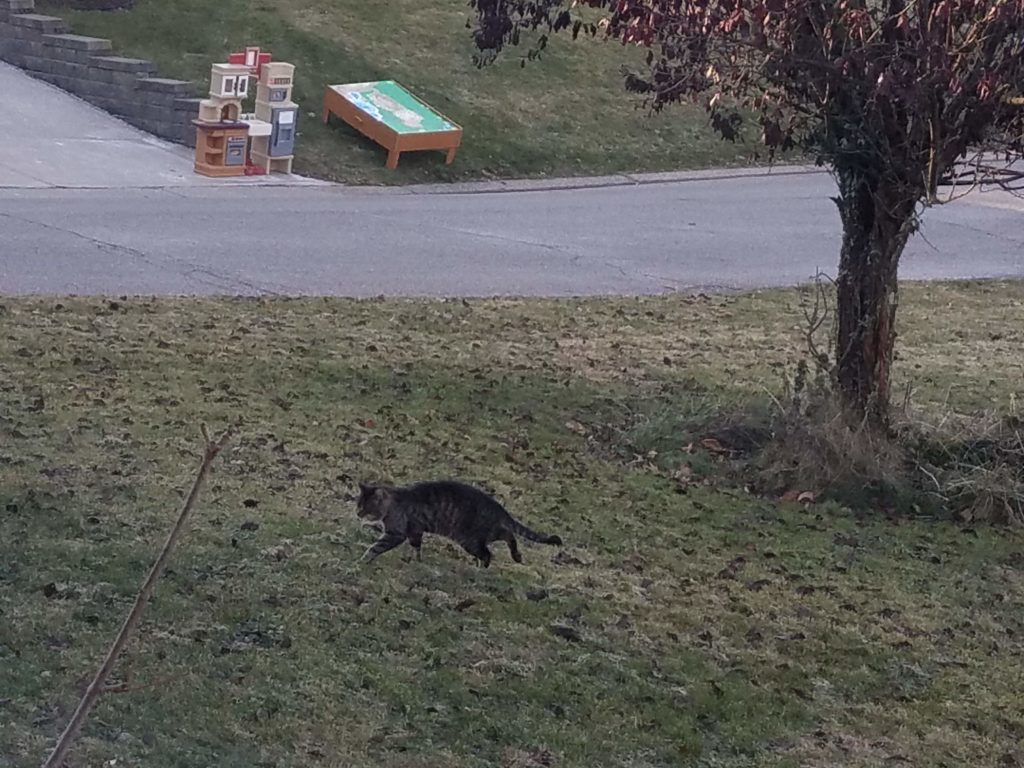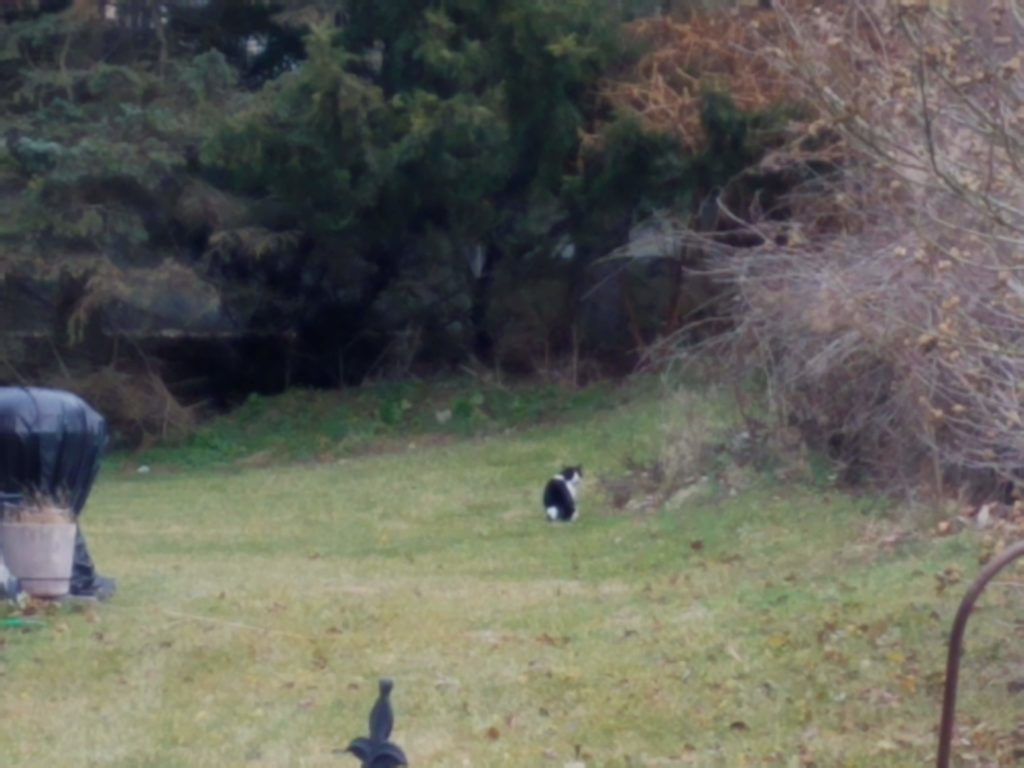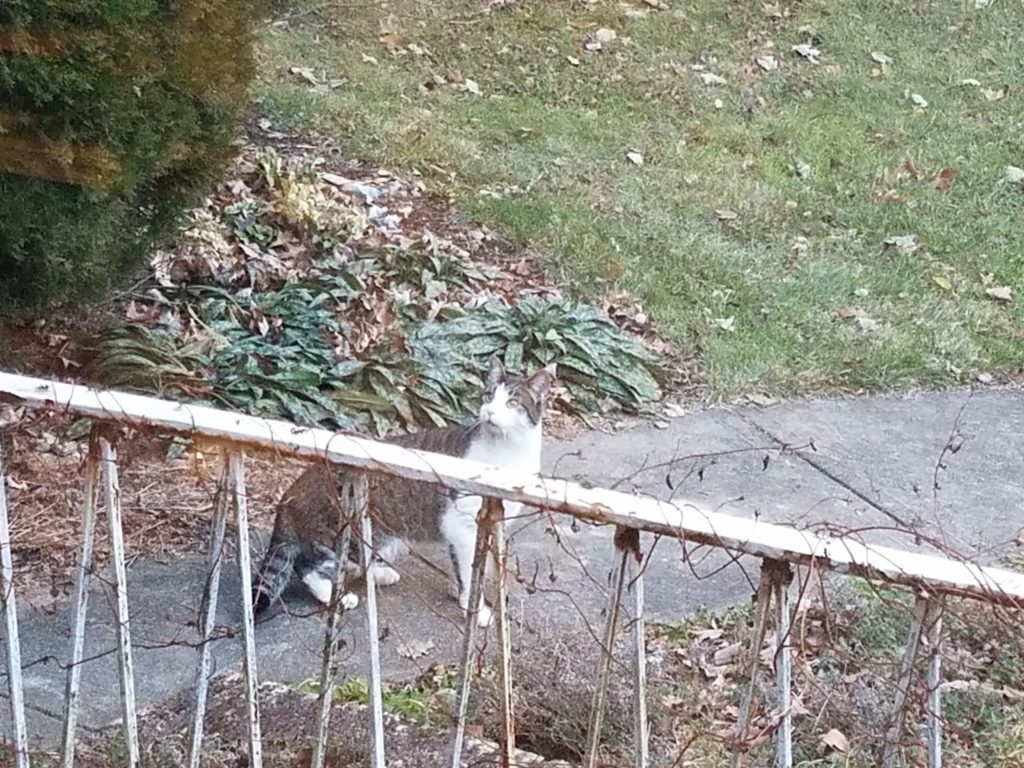If you’ve ever seen a stray cat missing an ear tip, you’ve seen a participant of a Trap, Neuter, Release/Return program. TNR kitties are usually fed, sheltered, and sometimes even vaccinated – and you can identify them by the missing ear tip, the universal symbol for the program.
As I mentioned a few weeks ago in my post on constructing shelters for feral cats,[1] the seasonal change at the end of December is what triggers the start of a new mating season.[2] While there is never a bad time to be trapping, neutering, and releasing neighborhood strays, now is certainly a good time to start.
We have several kitties in our neighborhood that were just kittens a year ago. We have watched them grow up from our kitchen window, and it was just in the last couple months that we started trying to interact with them. Once we finished up with the shelters and set them in the yard, we began leaving food nearby to coax the kitties closer. We also picked up my dad’s Havahart trap[3] at Christmas.

As of the writing of this post, we have not yet trapped any kitties, but hopefully it will just be a matter of time. In the meantime, I decided to pull together some information on Trap Neuter Release programs. I was surprised to find their benefit is much more contested than I expected.
Program Pros
Trap, Neuter, Release programs are designed to reduce the number of feral cats as humanely and with as little disruption to their lives as possible. Since feral cats are not socialized to interact with people, they are not necessarily good candidates for adoption. TNR kitties can return to their outdoor territories after surgery and live arguably better lives. Alley Cat Allies has a detailed list of studies that have been done over the years and across the globe demonstrating the effectiveness of TNR.[4] Some of the benefits as put forth in these studies are as follows:
- Stabilizes large colonies of cats in short- and long-term situations
- Reduces the number of calls to animal control
- Decreases number of cats admitted to shelters and number killed
- Frees up resources for cats already in shelters
- Eliminates undesirable mating behaviors (spraying, fighting, caterwauling)
- Lessens stress levels for cats, improves weight and body condition of cats
- Impacts population levels, even if it is not possible to spay/neuter every cat
One of these studies states that TNR is “the only effective method for stabilizing and reducing community cat colonies.”
Program Cons
While there are many proponents of these programs, there is some opposition as well. According to sources such as the American Bird Conservancy, TNR programs are a waste of time, money, and resources. Critics point to instances in which cat colonies were not stabilized and, in fact, increased over time. They also state that leaving feral cats in place, rather than relocating them, is “inhumane to the cats [and] perpetuates numerous problems such as wildlife predation, transmission of disease, and property destruction.”[5]

My Take on the Situation
Obviously shelters will be inclined to promote programs that result in less of a strain on their resources. Obviously bird advocacy groups are going to be opposed to the idea of allowing little murder machines (which cats absolutely are) out and about with free access to the bird population. I’m sure that there are situations in which TNR has worked well and situations in which it hasn’t, and that people and organizations on both sides of the argument may be guilty of cherry-picking data and anecdotes, each to prove a respective point.
However, I have not heard any reasonable alternatives suggested to be used in place of TNR. Most of the opponents to the practice will say that it’s ineffective or inhumane, but will not provide suggestions for an effective alternative, which makes us wonder what they have in mind.[6]
Removing cats from the area by any means (moving them to shelters, adoptive homes, more rural locations… or killing them) will only create a vacuum that new cats will move into and claim as their territory.[7] The cycle will repeat itself, creating more diseased, malnourished cats and draining more resources than if neutered cats were allowed to stay on their own territory. It is also worth pointing out that adoption is not always a realistic option with feral cats, even if there were a sufficient number of homes who wanted to take them in.

To me, it makes basic sense that if someone had caught our neighborhood’s stray momma cat and had taken her to get spayed before she got pregnant last year, that would have meant one operation, instead of the six or so we need to worry about now. TNR may not be a perfect solution, but with respect to our neighborhood kitties, it is certainly better than doing nothing.
What to Do
There are several resources in the Pittsburgh area if you want to get involved. Organizations such as Animal Friends offer humane trap rental (refundable $65 deposit) and low-cost spay/neuter surgery, which also includes vaccinations, parasite treatment, and an ear tip.[8] Merlin’s Rescue provides a comprehensive list of organizations that provide low-cost TNR services, including Humane Animal Rescue[9] and the City of Pittsburgh.[10]
Finally, I will take this opportunity to remind you should always spay and neuter your own pets – even if they’re indoor pets – and visit shelters instead of pet stores or breeders if you’re looking to add a pet to your family.

Do you have any experiences with TNR? I’d love to hear about them.
Thanks for reading!
[1] https://radicalmoderate.online/feral-kitty-shelters/
[2] https://veterinarypartner.vin.com/default.aspx?pid=19239&catId=102902&id=6656707
[4] https://www.alleycat.org/resources/trap-neuter-return-research-compendium/
[5] https://abcbirds.org/program/cats-indoors/trap-neuter-release/
[6] http://www.takepart.com/article/2014/03/31/sorry-cat-lovers-trap-neuter-release-flat-out-doesnt-work
[7] https://www.communitycatsunited.org/failed-alternatives-to-tnr
[8] https://www.thinkingoutsidethecage.org/pet-resources/feral-and-community-cats
[9] https://www.humaneanimalrescue.org/veterinarycenters/spay-neuter-services/
[10] https://pittsburghpa.gov/publicsafety/spay-neuter
1 Comment
Kate Panthera · November 4, 2021 at 7:21 am
I have thought well of the TNR program, and have participated in it. In the past, I fed feral cats who hung around my apt complex and caught them for the TNR. The program I participated in said they would only do the surgeries and vaccinations and release the cats back to my area if I guaranteed to keep providing them with food and water, which I did. I was under the impression that in all TNR programs, this assurance of reliable long-term provision of food and water for the animals was a pre-requisite. Over the years, the animals have ‘disappeared’ one by one, to the point of my not having any more in the area. However, I live next to a road where people speed along faster than they should, and there’s also a highway next to that. I had a neighbor who let some of her cats get out of her house on a regular basis, have 2 of her cats hit and killed by cars on the road next to me. i suspect that that was the reason for ‘my’ feral cats’ disappearance. I’d have a cat come around for food and water for a long time, and then one day just disappear, never to be seen again. I also worry about people possibly capturing and abusing the animals. As another person stated, you can’t re-vaccinate every year – it took over a month for me to trap the cats in the first place because they were so leery of going into the trap even when it was baited with tuna or wet cat food. And one last thing: after a long period of the cats being ‘ok’, 2 of them (at different times) developed some sort of wasting disease. I suspect they had a parasite like tapeworm, because they continually lost weight even when they ate. Or else they stopped eating. Again, it took a long time to capture them, even when they were in such a weakened state, because of their natural wariness of humans. One cat got to the point where all he did was lay on my front step all the time. He was almost skin and bones. I felt so bad about not being able to trap him until he was at death’s doorstep, and even writing this now after 5 years, I’m crying thinking about the pain he must have been suffering at the end. I did finally manage to trap both of them and have them euthanized, but I wonder if the pain they suffered at the end was worth keeping them alive in the first place. Although it makes me half sick to think of killing an innocent animal just because a negligent owner abandoned them or let them run loose or breed indiscriminately, I wonder if it isn’t more merciful to have them euthanized at the outset (if they’re truly feral and unadoptable), and let them pass peacefully and avoid a prolonged disease or violent death later on.